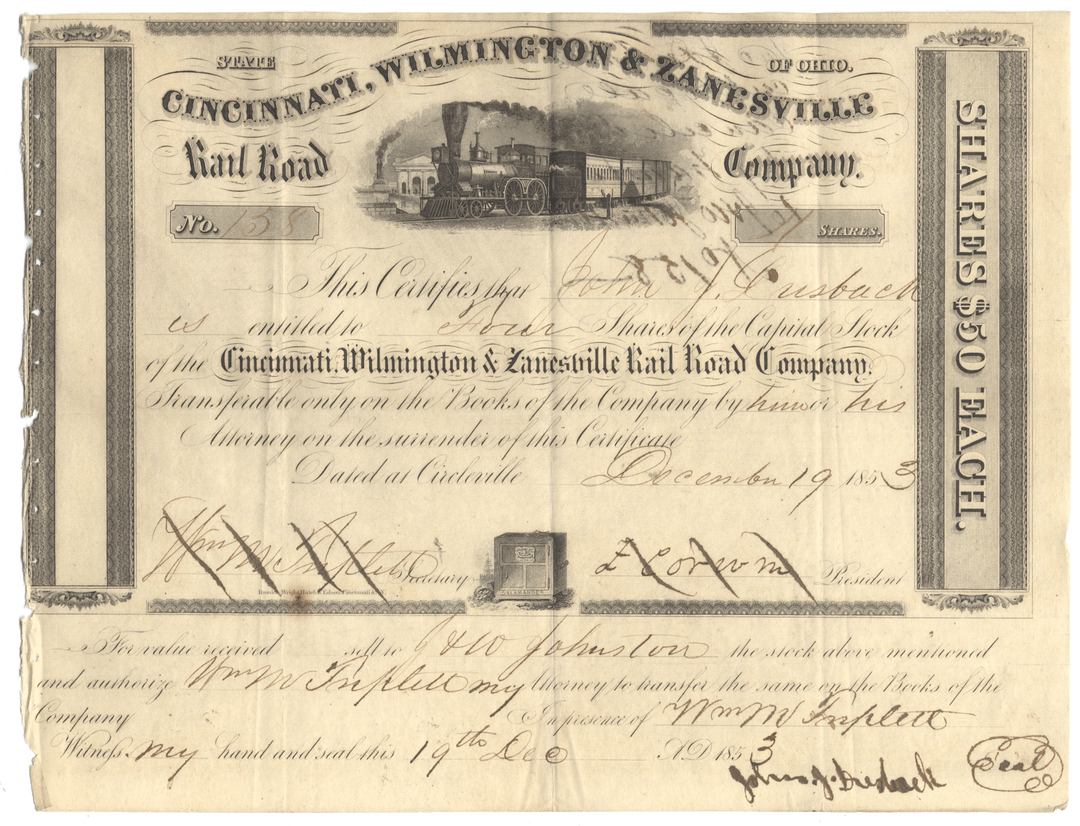
Cincinnati, Wilmington & Zanesville Rail Road Company
- Guaranteed authentic document
- Orders over $75 ship FREE to U. S. addresses
You will receive the exact certificate pictured
Over 150 years old
Capital stock
December 19, 1853
Issued, canceled
Rawdon, Wright, Hatch & Edson
Hand signed
10" (w) by 7 1/2" (h)
NA
Historical Context
In December, 1850, Hon. R. B. Harlan, the Representative of Clinton County in the Lower House of the Legislature, introduced a bill asking for development of the Cincinnati, Wilmington & Zanesville Rail Road, and the charter was granted February 4, 1851, the name of Wilmington being inserted out of respect to the county in which the bill originated. It was hoped that the road would be made a great through trunk line, but at the outset the mistake was made of connecting it with the Little Miami road at Morrow, and running its trains over the track of the latter company from that point to Cincinnati, and that fact interfered to a great extent with the success of the new road, which doubtless would have proved a better venture had its own track extended to Cincinnati.
In November, 1850, surveys and estimates were completed from Morrow to Lancaster, ninety miles, and the contract for building that part of the road was awarded to A. De Graff. Clinton County subscribed $200,000 toward its construction. Work was commenced in December, 1851. In the Clinton Republican of November 26, 1852, it was stated that over two thousand tons of iron for this road had reached New Orleans, to be forwarded at once to Cincinnati, and track-laying was to begin as soon as the weather in the spring would permit. The citizens of Wilmington then expected to have a train of cars running to their place by June 1, 1853. In the latter part of March, 1853, track-laying was commenced at Morrow. Numerous difficult places along the route delayed the work to some extent, but in the early days of August, 1853, the road was completed to Wilmington, and on the 11th that month a great celebration was held at said place in honor of the event. From 10,000 to 15,000 people were present, including about two thousand five hundred who arrived at 11:15 A. M. on a train of twenty cars. Speeches were delivered by several prominent men, and the occasion was greatly enjoyed. The big train left at 3:30 P. M., and by 6 o'clock all was again quiet in the village.
Trains began running regularly between Cincinnati and Wilmington, one a day each way, on the lath of August, 1853; fare between the two points, $1.60. November 24, 1853, the company had completed the road to Washington, Fayette County, and began on that day to run its trains to that point, forty-one and one-fourth miles from Morrow, and seventy-seven and one-fourth miles from Cincinnati. In 1854, the road was finished to Lancaster, and the contract was let the same year for building the portion between Lancaster and Zanesville. Late in 1855, the line was completed to the latter place, and in 1856, trains were running uninterruptedly over the entire length of the road.
Franklin Corwin was the first President of the company, from 1851 to 1856. He was succeeded Erasmus Gest, as President and Superintendent. Mr. Gest was succeeded by Col. William Key Bond, who managed affairs four and a half years. In October, 1863, the road was sold at auction and purchased by Charles Moran, of New York, in trust for the first mortgage bondholders. In March, 1864, the property was transferred by him to a re-organized company, composed wholly of original stockholders and creditors, upon a capitalized or reduced basis.
The name was changed to the Cincinnati & Zanesville Railroad Company. December 1, 1869, the road with all its franchises, real estate, machine shops, depot buildings, and rolling-stock was sold at auction at the door of the court house in Cincinnati, to Judge Thomas L. Jewett, President of the Pennsylvania Central Company, for the sum of $1,004,000. On May 1, 1873, the road passed to the hands, by lease, of the Pittsburgh, Cincinnati & St Louis Railroad Company, by whom it is at present operated under the name of the Cincinnati & Muskingum Valley Railroad.
Related Collections
Additional Information
Certificates carry no value on any of today's financial indexes and no transfer of ownership is implied. All items offered are collectible in nature only. So, you can frame them, but you can't cash them in!
All of our pieces are original - we do not sell reproductions. If you ever find out that one of our pieces is not authentic, you may return it for a full refund of the purchase price and any associated shipping charges.





